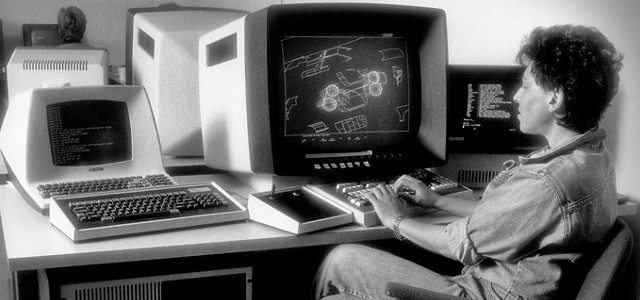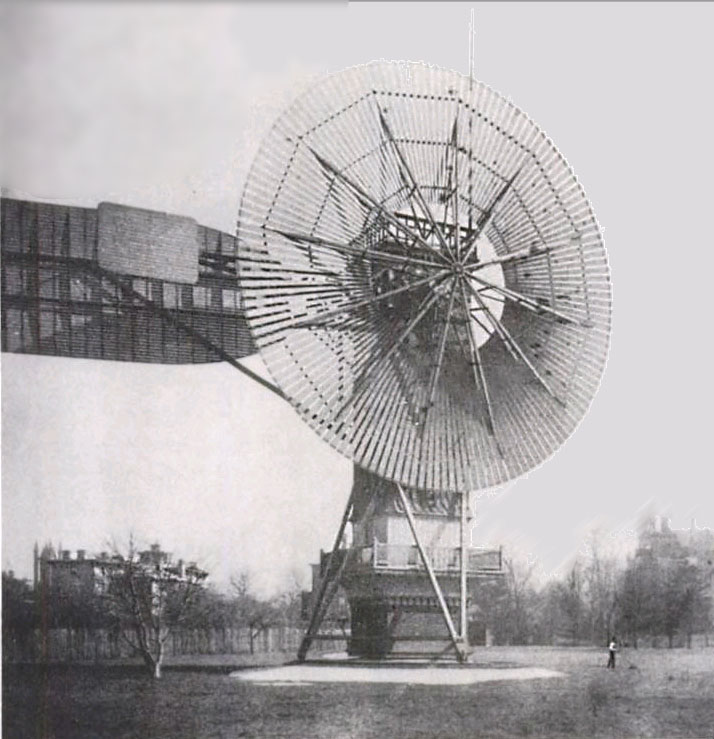Billionaire Bill Gates claimed this summer that breakthroughs are needed for the energy transition and that funding should be diverted from current technologies towards R&D. Craig Morris wonders what would have become of Microsoft if we had waited for Ultrabooks before buying computers.

If you always wait for the next big thing to go on sale, you will never actually purchase any piece of technology. But if we hadn’t purchased the computers shown above, we wouldn’t have gotten the great stuff we use today.
Gates’ comments have been reported in various places, primarily among skeptics of renewables. He essentially argues that the renewable energy technologies we have today are not good enough – further breakthroughs are needed. The call for R&D is welcome; the denigration of existing technologies, less so. It is already clear what role most things Gates mentions will play, and breakthroughs are not needed. Deployment will provide sufficient innovation.

An Arctic explorer in the 1890s with a wind generator on board to provide electric light. The basics have been understood for a long time; there have been no breakthroughs. None were needed. Source: Wikipedia.
Gates says current technologies are too expensive. Someone should tell him that solar power now costs less than nine cents in Germany, less than six cents in Dubai. It is expected to reach 4-6 cents by 2025 and 2-4 cents by 2050 in a conservative estimate (PDF) – but only if we keep building. Wind power ranges from as little as five cents in Germany to less than three cents in the US.
No breakthroughs are behind these low prices. For solar, the polycrystalline solar cells that dominate the market today have been continually tweaked over the past decades, but the innovation was incremental. Sure, there have been improvements, but cell and panel efficiencies have crept upwards, not skyrocketed. For instance, manufacturers began texturing cells as pyramids so that sunlight would bounce back and forth, rather than upwards away from the cell. Small, but helpful tweaks.
What really brought down the price of PV was not pyramids, but mass production. Production lines used to be cobbled together with equipment from different industries. By around 2007, equipment manufacturers started making dedicated turnkey PV production lines, which dramatically brought down cell and panel costs – and such mass production would not have been possible without mass markets (read: deployment).
The solar array on the roof of the German city of Freiburg’s football stadium from the mid-1990s has panels screwed on with nuts and bolts. Installation must have taken ages. Today, installers clip panels into place in just a few seconds, cutting installation time (and cost) down to a fraction of the level of decade ago. No breakthroughs here at all, just deployment tweaking.

A wind turbine that generated up to 12 kilowatts of electricity. Built in 1888 by engineer Charles Brush, it ran smoothly for 20 years in Cleveland. Source: Wikipedia.
Wind power is no different. In 2014, I helped put together a list of 10 milestones in wind power technology (PDF). To me, they are important incremental innovative tweaks, not breakthroughs. In the US, making rotor blades longer and towers taller without increasing generator size now means that wind power can be generated affordably in the entire country – with turbines we have today.
Betz’s law describing the maximum amount (59 percent) of energy that a turbine can produce from wind was first discovered in 1919, when rotor blades were still boards hammered together. Enercon machines now peak at 80 percent of that limit and are at 70 percent over a wide range of common wind speeds. There simply isn’t much room for improvement, so what exactly does Gates want?

The power coefficient (white line) of Enercon’s tallest turbine close to the theoretical limit of 0.59. Source: Enercon.
He wants high-altitude kites to trap the energy in jet streams, which will not work; the air density is so low at those altitudes that the kites would stop the wind as much as harvest energy. He says battery technology is not “even close to allowing us to take all of our energy from renewables”; fortunately, Germans realize that batteries are better for grid stabilization than power storage. He wants “solar chemical” power, which is simply power-to-gas (P2G); it exists – no breakthroughs needed, just deployment to improve efficiency and bring down costs.
As an entrepreneur, Gates failed to see the significance of the Internet, which eventually brought about Google. He failed to see mobile and touch coming, where Apple reigns. To him, these changes must have seemed like upheavals – like breakthroughs. But this progress was incremental and came faster because of mass sales of PCs running on Windows 95 and 98 – operating systems that crashed so often (daily) that I developed a habit (now lost) of typing Ctrl+S after every period. We have amazing Ultrabooks today because large numbers of less impressive computers were bought beforehand. And Windows runs stably now. Likewise, the energy transition will only bring about similar innovative tweaks if we build what we have today.
Craig Morris (@PPchef) is the lead author of German Energy Transition. He directs Petite Planète and writes every workday for Renewables International.
Some good points made in this article.
Most wars are won by fighting on all fronts and most technological “breakthroughs” come about through progress across several inter-related areas. That was certainly the way the automobile with ICE engine came about.
That said, I think we do need to put money into potential novel technologies as well as current renewables.
Another point: I don’t think the costs for renewables take into account cost of storage. Essentially we are avoiding those costs at present but if we to move to say 80% reliance on wind and solar we will need massive storage.
The argument here, a comparison of computers and renewable energy does not quite cut it. We bought the early computers because they were vastly superior to their competitors: slide rules, mechanical calculators and the like technology. They saved costs and were more efficient. They gave ordinary people power to do things that simply were not within their reach before.
The same goes with ICE cars compared to electric cars, horses and bicycles. The advantages were there from early on.
If we want to get rid of fossil-fuel backup capacitiy (without deploying nuclear power plants for that purpose), we either have to build pumped hydo storage everywhere or we have to reduce the costs of other storage technologies by a factor hundred or so. Maybe, Mr Gates was adressing the latter issue.
At the moment, we are heading to a world, where renewables have to stop at around 50% to 60% of yearly production. Because there is no feasable way to store enough energy for the times without much wind and sunshine.
Excellent article. Gates’ naivete on solar and wind energy is also very well described by Jigar Shah in http://www.greentechmedia.com/articles/read/sorry-bill-gates-you-are-wrong-on-clean-energy , who notes amongst other things that:–
“The truth is that an over-reliance on centralized grid extension and large-scale power plants will keep a billion people in the dark. It is time to recognize what even the IEA says is overwhelmingly necessary, but dramatically under-invested in: distributed renewable energy for those living beyond the grid.
“To understand why this is so important, take a step back and consider the reaction if Gates wrote a blog suggesting that Mark Zuckerberg is a fool and that the solution for universal internet access around the world is connecting every home around the world via physical fiber-optic cable. The reaction would be riotous laughter. In emerging markets, they are busy ripping out copper and everyone is using wireless. Yet that’s exactly analogous to what Gates is proposing for energy.”
See especially the last 2 sentences.